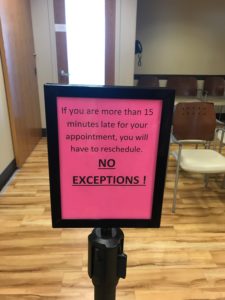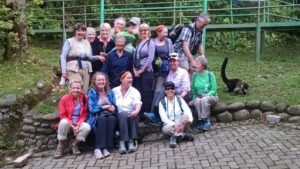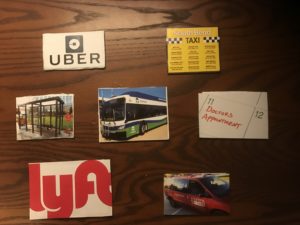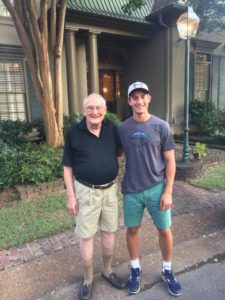Joe, accompanied by Alex, visited the office of Volunteer Services at Saint Joseph Regional Medical Center (Hospital) in order to determine what roles the volunteers play in terms of transportation for patients. The team members spoke with Cari Wilson, Director of Volunteer Services, as well as Robert, one of the daily volunteers. In talking with Cari, the team discovered that there are multiple resources for patients to use in order to get to the center, but some of the time they simply are not aware of those services. For instance, a patient may not be aware that the Transpo bus runs every hour to and from the hospital. Rob, who works at the front of the building welcoming people, informed the team that it is very rare for a patient to come to the hospital and then face a transportation problem leaving the hospital. This is because, in most cases, patients will not come to the center without planning their travels beforehand. The ethnographic summary of the interviews is attached below, along with a few pictures pertaining to the interviews.
Category: Projects Spring 2017
Ethnography Interview Summary- Ranae: Family Medical Center
Ethnography Summary- Ranae: Receptionist at Family Medical Center inside Saint Joseph’s Hospital
Team members Joe Krause and Alex Charron interviewed receptionist Ranae in order to determine how often appointments are missed and cancelled with the Family Medical Center of SJHS .
Date: 3/4/17
Type: Interview
Location: Family Medical Center within Saint Joseph’s Hospital in Mishawaka, IN.
Team participants: Led by Joe Krause and accompanied by Alex Charron
User Characteristics: “Veteran Receptionist for the Family Medical Center”
- 10+ years handling patient appointments, cancellations, and no-shows
- Helps register patients who have appointments
- Makes reminder calls to ensure that people are aware of their appointment
Memorable Quote- “The transportation services provided through Medicaid are inefficient and often result in a patient being so late that they completely miss their appointment.”
Top 3 Learnings:
- Access to transportation in order to get to a medical appointment is a much bigger problem than people think.
- Medicaid will pay for transportation to appointments, but they require a 72 hour notice and the patient must use specific approved cab companies. These cab companies often show up late, causing a patient to be late to an appointment.
- There are a lot more cancellations than no-shows because a patient may lose complete access to the office if they miss a few appointments with no advanced notice. However, no-shows are unproportionally due to lack of transportation.
Key insight- Medicaid will cover the costs to get to and from an appointment, but most of the time cab services are late which cause patients to also be late. The family medical center has a policy that if a patient comes more than 15 minutes late, then their appointment will be cancelled automatically. Furthermore, not all patients are aware that medicaid will cover transportation expenses, so they look for alternative ways of getting to appointments that do not always work.
Activities:
- Met Alex on campus and took uber to the hospital.
- Spoke with various employees and patients
- Took referrals in order to gain the perspective of multiple stakeholders
- Left the hospital
Environment:
- Saint Joseph’s Hospital
- Family Medical Office

Ethnographic Research — Individual Interview #1
I conducted my first interview over the phone with my Grandma, Judy Hinton. Judy is 76 years old and lives alone in Bow Mar, Colorado. The purpose of this interview was to gain an insight on what allows her to successfully remain in her home alone, her daily interactions with technology and the extent of her relationships with her doctors and family.
Date: February 28, 2017
Type: Phone interview
Location: Lives in Bow Mar, Colorado
Team Participant: Participated alone
User Characteristics:
- Post-retiree who remains in her house, living alone
- Age: 76
- Gender: Female
- Marital Status: Widow
- Occupation: Volunteer at Tabor Opera House and Preservation Colorado
Memorable Quotes:
- “I couldn’t imagine living anywhere else, this is where I raised my kids and my grandkids. It’s full of happy memories”
- “Tabor and I love our walks because we get to have fun with our friends and be active! Its how we stay young!”
Key Insights:
- Desire to stay in her home
- Daily exercise is motivated by social aspect and her dog
- Willingness to learn technology if someone takes the time to teach her
Where are you currently living?
- “I live at 5*** Morning Glory Lane. Its been my home for 43 years”
- “I couldn’t imagine living anywhere else, this is where I raised my kids and my grandkids. It’s full of happy memories”
Would you ever want to move out of your house?
- “No I don’t think so. I love it here, I have my yard for Tabor to run around in, I know all my neighbors, and my family is close”
- Her bedroom is on the second floor
- “If the stairs ever became too much, I would move my bedroom down to one of the first floor bedrooms before I left my house”
How often do you see a doctor?
- “I’d say I go in twice a year just for routine checkups”
- “I have been very lucky with my health”
Do you personally do anything to track your health?
- “I walk my dog with my friends or my son everyday and I wear a fitbit so I know how many steps I get in”
- “I mostly just try to stay active and hike with my group”
- Has a hiking group she meets with once or twice a week
- Went on hiking vacation in Costa Rica earlier this year. Her and her friends all wore and compared fitbits, and IPhone health trackers
- “As long as I am hiking and walking Tabor I feel healthy”
- “Tabor and I love our walks because we get to have fun with our friends and be active! Its how we stay young!”
- Her and her friends all walk their dogs together almost everyday
Would you like your doctor to receive your daily health stats and be able to monitor your day-to-day health without having to visit the him/her?
- “I don’t know if it would be necessary but I think it would be neat!
Would you want your family members to be able to receive this information too?
- “I would want to be able to choose what they could see, I wouldn’t want them to know everything”
How comfortable are you with technology?
- “I use my IPhone, and IPad everyday, but I’m no expert!”
- I defiantly get frustrated with it sometimes and I don’t understand everything they do or can do but I try to keep up”
- “If someone teaches me how to use it, I’ll use it! I just need someone to teach me!”
Takeaways:
The daily activity that allows her to stay healthy and completely independent is motivated by companionship. Whether she receives this companionship form her dog, her neighbors or her hiking group, the motivation to be with or socialize with others is what gets her walking and keeps her healthy, which in turn allows her to independently and successfully age in place.

Interactive Ethnography

These are images of various aspects of a typical journey to and from medical services for someone living in poverty. I will ask people how they feel about each image as part of my interactive ethnography.
Expert Interview: Kari Tarman, Oaklawn
Kari Tarman heads Marketing and Communications at Oaklawn. Oaklawn is an organization that provides mental health and addiction services in South Bend, Mishawaka, Goshen, and Elkhart. The organization provides transportation for many of their clients since they are unable to drive. Learning about their transportation services provided insight into how we can help St. Joseph Health System with their issues transporting patients. Below are the questions I asked with summaries of our discussion, as well as key insights gained.
Could you please tell me about Oaklawn’s mission and the specific population you serve?
- 80% of Oaklawn’s clients are Medicaid/Medicare recipients. This is relevant since Oaklawn can bill these programs for transporting the clients.
- Oaklawn provides inpatient and outpatient services, including a residential program at one location.
- There are two main barriers for their clients securing transportation. One being they are physically unable to drive and two being they felt stigmatized being in public.
- “With all of those barriers for people to come to services, we found that providing transportation increases engagement in services. So we have better success treating clients, better medication management, better relationships with our clients.” (Tarman)
How does Oaklawn bill for transportation?
- Clients must meet certain criteria on a sliding scale to be considered a “billable account”. This includes type of patient condition, type of appointment, and several other parameters.
- It appears that smaller organizations are less willing to bill for transportation because they do not have the administrative resources.
- Oaklawn has a system that keeps track of patient records, cancellations and missed rides, and many other factors to continually assess the efficiency of their transportation service.
- Richard, a driver who spent part of the interview with us, thought the base rate for a one-way ride was 50 cents.
What are the efficiencies and inefficiencies of Oaklawn’s transportation service?
- There are 4 drivers, sometimes 5, and each drives an Oaklawn registered van that holds 7 passengers. Sometimes they use a sixth car if one of the vans is not working or they are too busy.
- The drivers are local area residents and are very familiar with the area.
- Kari mentioned employing your own drivers is beneficial in that you can train them specifically to work with your clients.
- Another pro of providing your own transportation is that it “gives you a credibility source as an organization to say we offer this service to the community and we’re working to serve this population.” (Tarman)
- It is crucial to be able to communicate with clients or their support network to assess whether they want to continue to use the services.
- Richard mentioned often times they are overwhelmed and drivers must be able to be flexible and pick up other clients that may have been on another driver’s route.
- The vehicles do require periodic maintenance. Each van has a gas card and car wash voucher provided by Oaklawn.
- The biggest challenges are clients living in different locations and that fact that many appointments vary in length so it is sometimes difficult to schedule.
What are the pros and cons of South Bend Transpo, private companies like Uber and Lyft, and services provided by the specific corporation?
- Public transportation
- It is not used in South Bend as frequently as other places. There may be a stigma attached to using such services.
- If people do use it though, it is cheaper for the city in the long term
- It typically takes a longer time to get from point A to point B on a bus than by other means.
- Uber/Lyft, etc
- Difficult for corporations to expense
- May not be trained to work with specific clients
- In house transportation
- Hiring drivers allows for more personalized training and results in more accountability.
- The corporation looks good in the eyes of the public.
- Resources must be allocated to implement and maintain the services.
Do you mind providing some insight into the typical day as a driver?
- Drivers are told to honk upon arrival at a client’s residence. If they do not respond in two minutes the driver calls the supervisor to make a decision.
- If a client has two no shows or cancellations, they are placed on will call and must make an extra phone call each morning they are scheduled for a ride until the supervisor deems they are in good standing.
- Drivers use radios and now smart phones to keep in constant communication with other drivers and the supervisor.
- Other than driving, drivers keep track of mileage and whether clients showed up or not.
Key Insights:
- A transportation service must be structured so that the service is flexible and able to deal with issues as they arise.
- Ideally, the clients view the service as a privilege so that they follow through on their commitments to use the transportation service. Increasing cancellations and no shows hurts Oaklawn financially and in other ways.
- Although funding is required for a transportation service, the service likely enhances the quality of interactions between the organization and their clients.
- It is a huge benefit to be able to communicate with clients whether or not they want to continue to use the service is they have missed several rides. An inability to communicate with patients who do not show up to their rides may provide a huge issue.
- A corporation must have the resources in place to bill for transportation.
Ethnographic Research — Individual Interview #1
I interviewed Raymond Shainberg, my grandpa, on his experience in his retirement community in Memphis, TN. The purpose of interviewing this subject was to hear his motivation for voluntarily moving out of his home, despite him and his partner’s health and ability to live safely on their own. I focused less on his willingness to adopt technology, and more on the emotional/social factors that influence one’s desire to stay-at or leave their homes.
- Date: February 28, 2017
- Type: Phone Interview
- Location: Lives in Memphis, TN
- Team participants: Conducted alone
- User Characteristics:
- Post-retiree who moved out of his house voluntarily
- Gender: Male
- Age: 86
- Occupation: “Retired” Lawyer
- Started to phase out retirement when he was 82
- Retired at end of the year but still goes in about once per week to advise and to take care of clients
- Technically in senior council
- Education: Yale B.A. ’53, Yale Law ‘56
- Memorable Quotes:
- “It’s carefree living for the older people. We don’t have to do a damn thing!”
- “I could’ve retired earlier but what was I going to do? Stay home and do nothing? Once I came here 3 years ago, I was given alternatives besides sitting at home and twiddling my thumbs!”
- “These communities are getting more popular.”
- Key insights: Importance of the social factor
- Patterns: Choice, desire for activity, health
Where are you living now?
- “It’s a retirement community. I live in a private villa with Judy in a community of about 175 apartments”
- “If I get to the point where I can’t handle things myself, there’s 20 or so assisted living and dementia/Alzheimer’s units. Along with 70 or so full care facilities and a rehab unit for people who need help if they fall or something. Doctor every morning, nurse all day. There’s also a health club and trainer for people over the age of 86.”
- There’s a movie 5 nights a week at the theatre, a library to check out books, a pool, and more
- He is very passionate about the food options
- He eats most dinners at the facility (called the Big House), and breakfast and lunch in their home
- Wears alarm around neck that if pressed, will make people show up in 90 seconds
- Average age is somewhere in the 80s
What motivated you to make the choice to move out?
- “We moved out because of the services available to us here, if we needed them. There’s a medical clinic that you can go to any morning if you don’t feel good, and if it’s too bad, they’ll get you to a hospital.”
- “They’ll come and change a lightbulb or provide other kinds of maintenance in 10 minutes”
Do you like your neighbors?
- “Oh yeah! We eat almost every meal with people out here. You never have to eat by yourself.”
- “We knew a few people coming in but met a lot more. There’s always people to talk to.”
- “There’s a woman who is 101 and is active and walks, and a Rabbi who is 99 and active too”
What did you do today?
- Tai chi class in the morning
- Rode around in his golf cart
- “I took bridge lessons from 10-12. Four of us are learning from a teacher!”
- Lunch in the house
- Went to the office to take care of stuff for 2 hours
- Came home and relaxed
- Had dinner with 4 other people at the Big House
- Had a Mardi Gras meal in the main dining room and party from 6:30-8!
Are you technologically savvy?
- “Medium. I use a Mac an iPad and printer”
How often do you see a doctor?
- “I see my regular doctor generally once a year for a check up. Maybe a couple of times for sore throat. I see my heart doctor 3x per year to check the pacemaker”
- Has seen doctor annually last 20 years – since he was 65
Do you think about your health often?
- “Yes, I really do. It worries me now at 86. But it hasn’t always been that way.”
- Got bronchitis on cruise in Alaska last year and that started me worrying
- “We come from hardy stock, Jonah!”
Do you miss the house?
- “No, not at all. Life is so much simpler here”
How much does it cost?
- $5000 per month (including food), but they pay for all utilities, maintenance, and cleaning
Are you happy with your current surroundings?
“From 1-10, it’s a 10”
Takeaways: While health is a crucial factor that affects post-retiree’s ability to remain at home, it is not always the motivation to move out. The desire for companionship and activities are a huge draw for many, and retirement communities that offer healthcare services are often the answer. If our goal is to use the IoT to help post-retirees age in place, we will need to take the social factor into account. It’s not only about health monitoring.

Questions to ask Interviewees
- Why do you think people attend the Boys & Girls club? Why don’t some people attend?
- What do you think the main benefits of Boys & Girls club are?
- Do you think the name makes teenagers not want to attend?
- If you had kids, would you send them to the club?
- What is the difference between the Boys & Girls club and a normal daycare?
- Why do you attend the Boys & Girls club?
Fr. James Martin
https://en.wikipedia.org/wiki/James_Martin_(priest)
Ethnography Feedback
Great job with the interview summaries so far team! You captured some great insights! Keep up the great work. It will be very interesting to see the patterns that emerge.
Ethnography Interview with Rodney Smith at Soup Kitchen
Date: 2/17/17
Location: United Methodist Church
Participants: Paul and Parker
Profile of Interviewee:
- Male, mid 40’s
- White
- SB native
- Criminal Record
- Questionable substance abuse (current or prior)
- Unemployed
Summary: On February 17, we interviewed Rodney Smith (alias), at the Downtown Soup Kitchen and Food Pantry. Over the course of the last 15 years, Rodney has bounced around South Bend, living in the Center for the Homeless and many different friends’ apartments. He has a criminal criminal record (3 Felonies from the early 2000’s), a knee injury, and is recovering from substance abuse. We were able to learn many different things about the South Bend homeless community from his many experiences in various living arrangements. He is currently taking classes at the Center for the Homeless in hopes of landing a job interview when his knee is back to full health. Rodney seemed to be back on the right track in his life, but with a criminal record, an injury, and prior substance abuse, he was the first to admit that even finding an interview will not be an easy task.